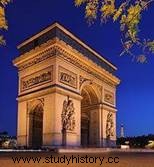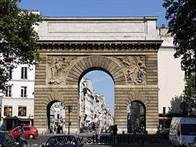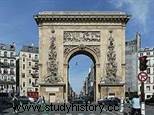 In our memory we count two Arcs de Triomphe in Paris, raised to the glory of our kings and other great personages. And yet, there are four of them! A well-known one, a second maybe a little less and the last two which bear the name of "Porte" but which are indeed triumphal arches!
In our memory we count two Arcs de Triomphe in Paris, raised to the glory of our kings and other great personages. And yet, there are four of them! A well-known one, a second maybe a little less and the last two which bear the name of "Porte" but which are indeed triumphal arches!
The Arc de Triomphe de l'Etoile and the Arc du Carrousel
The one that everyone believes to be the only one is the Arc de Triomphe de l'Etoile at the top of the Champs Elysées, erected from 1806 by Napoleon and completed between 1832 and 1836 under Louis Philippe. Designed by Jean-François Chalgrin and completed after his death by Jean-Armand Raymond in 1836, it was inspired by the Arch of Titus in Rome. The great battles of the Revolution and the Empire are engraved on it. It is the last of the series of four. Some time before, the Arc de Triomphe du Carrousel was commissioned in 1806, again by Napoleon. Installed at the end of the Tuileries Garden, it celebrates the victory of Austerlitz and the campaign of 1805.
The lesser known
 If you walk along the Grands Boulevards of Paris, you arrive at Porte Saint Martin and Porte Saint Denis. These monuments are not called "Arc de Triomphe", yet the design and purpose of the construction are identical:a central arcade flanked by two pillars, decorated with bas reliefs celebrating the victories of... Louis XIV! These monuments take the name of gates because they were installed on the site of the fortifications which surrounded Paris to the north.
If you walk along the Grands Boulevards of Paris, you arrive at Porte Saint Martin and Porte Saint Denis. These monuments are not called "Arc de Triomphe", yet the design and purpose of the construction are identical:a central arcade flanked by two pillars, decorated with bas reliefs celebrating the victories of... Louis XIV! These monuments take the name of gates because they were installed on the site of the fortifications which surrounded Paris to the north.
The Saint Martin Gate

Built in 1674, on the Grands Boulevards desired by the Sun King between 1668 and 1705, it is located at the intersection of the Saint Martin axis and the Saint Denis boulevard. On the low reliefs, on the south side, are represented the taking of Besançon in 1674 and the Breaking of the Triple Alliance. Opposite on the north side, the sculptures correspond to the Capture of Limburg in 1675 and the defeat of the Germans. The attic on the south side bears the inscription "To Louis the Great, for having twice taken Besançon and Franche-Comté, and defeated the German, Spanish and Dutch armies".
Saint Denis Gate
 Colbert wanted to separate the city from the suburbs. This is how the Saint Denis gate was erected in 1672, on the site of the gate of the enclosure of Charles V. This "triumphal arch" is built on the model of the arch of Titus in Rome, with a large arch and two small side doors, raised in the pedestals of the obelisks. On the south side, the sculptures represent the victories of Louis XIV on the Rhine, Holland and the United Provinces being defeated. In the north, it's victory in Maastricht...because in the space of two months, the king has crossed four rivers, conquered three provinces, stormed forty strongholds and triumphed over Utrecht! In the frieze of the entablature, we can read in bronze letter "Ludovico magno" (To Louis the Great).
Colbert wanted to separate the city from the suburbs. This is how the Saint Denis gate was erected in 1672, on the site of the gate of the enclosure of Charles V. This "triumphal arch" is built on the model of the arch of Titus in Rome, with a large arch and two small side doors, raised in the pedestals of the obelisks. On the south side, the sculptures represent the victories of Louis XIV on the Rhine, Holland and the United Provinces being defeated. In the north, it's victory in Maastricht...because in the space of two months, the king has crossed four rivers, conquered three provinces, stormed forty strongholds and triumphed over Utrecht! In the frieze of the entablature, we can read in bronze letter "Ludovico magno" (To Louis the Great).
To go further
Nicolas Eybalin – When places tell the story of France. Scineo Editions, October 2012.
